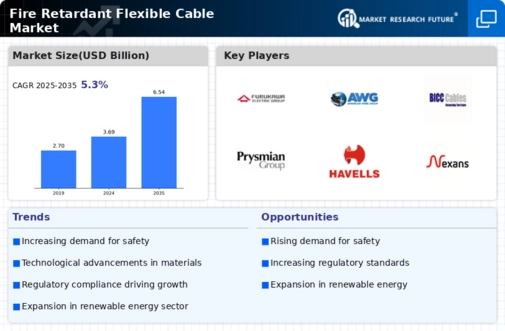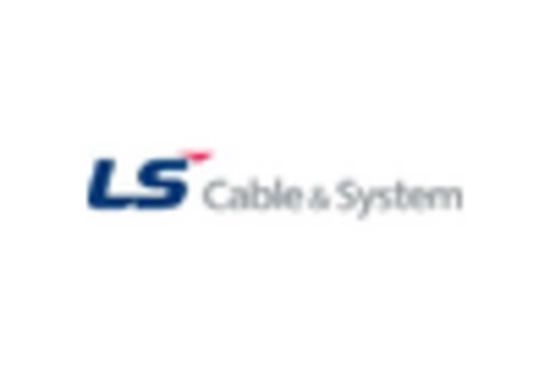The Fire Retardant Flexible Cable Market is currently characterized by a dynamic competitive landscape, driven by increasing safety regulations and a growing emphasis on fire safety in various sectors, including construction, automotive, and industrial applications. Key players such as Nexans (France), Prysmian Group (Italy), and Southwire Company (US) are strategically positioning themselves through innovation and regional expansion. For instance, Nexans (France) has focused on enhancing its product portfolio with advanced fire-resistant materials, while Prysmian Group (Italy) has been actively pursuing mergers and acquisitions to bolster its market presence. These strategies collectively contribute to a competitive environment that is increasingly focused on technological advancements and compliance with stringent safety standards.
In terms of business tactics, companies are localizing manufacturing to reduce lead times and optimize supply chains, which appears to be a critical factor in maintaining competitiveness. The market structure is moderately fragmented, with several key players exerting influence over pricing and product offerings. This fragmentation allows for niche players to emerge, yet the collective strength of major companies like General Cable (US) and Belden Inc. (US) ensures that competition remains robust and innovation-driven.
In August 2025, Prysmian Group (Italy) announced the launch of a new line of fire retardant cables designed specifically for high-rise buildings, which underscores its commitment to addressing the evolving safety needs of the construction industry. This strategic move not only enhances its product offerings but also positions Prysmian as a leader in compliance with new building regulations, potentially increasing its market share in a growing segment.
Similarly, in September 2025, Southwire Company (US) unveiled a partnership with a leading technology firm to integrate AI into its manufacturing processes. This initiative aims to enhance production efficiency and product quality, reflecting a broader trend towards digital transformation in the industry. By leveraging AI, Southwire is likely to improve its operational capabilities, thereby gaining a competitive edge in the market.
Moreover, in July 2025, LS Cable & System (South Korea) expanded its operations in Europe by establishing a new manufacturing facility in Poland. This strategic expansion is indicative of LS Cable's intent to tap into the European market's growing demand for fire retardant cables, which may enhance its supply chain efficiency and responsiveness to regional customer needs.
As of October 2025, the competitive trends in the Fire Retardant Flexible Cable Market are increasingly defined by digitalization, sustainability, and the integration of advanced technologies. Strategic alliances are becoming more prevalent, as companies recognize the importance of collaboration in driving innovation and meeting regulatory demands. Looking ahead, it appears that competitive differentiation will evolve from traditional price-based competition to a focus on technological innovation, product reliability, and sustainable practices, which are likely to become the new benchmarks for success in this market.

















Leave a Comment